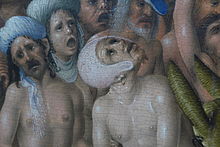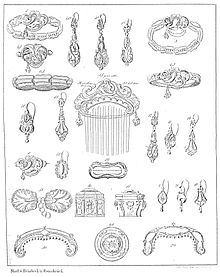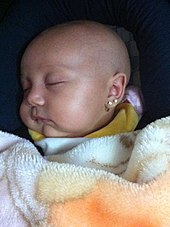Earring

An earring is a piece of jewelry worn on the ear . It is attached either through an ear hole in the ear or as an ear clip on the earlobe . Earrings were and are worn by all genders in many cultures around the world, but more often by women.
Earrings are often made of metal , but bones , wood , plastic, and other hard materials are also used. The parts can be made of almost any material, including glass , gemstones, and pearls . The shapes of the earrings vary from small rings or pins to large pendants. The load capacity of the ear hole (and the ear) and the diameter of the suspension limit the size and weight.
history
Ancient cultures
The earliest find of earrings to date dates from 7500 to 8200 years and was made in the city of Chifeng in Inner Mongolia . There are several pairs of jade that are 2.5 to 6 cm in size .
In Ur , crescent-shaped earrings were worn by women. Earrings have been found in Egypt since the 18th dynasty . Greek women wore earrings of all kinds, including figuratively decorated and vase-shaped pendants. Byzantine earrings had an influence on the style of jewelry throughout the Mediterranean and the Islamic Orient. From Roman times, ornamental openwork discs set with stones are known as female earrings.
Middle Ages in Europe
In Oswald von Wolkenstein's legacy, the song Es fuegt describes how a Spanish noblewoman (queen of Arragum) pierced her ears with a brass needle and inserted rings.
"I was traded from iren in the oren my / stung through with a measuring needle / after ir wonet si me zwen ring dorein / di loyal long, and they are called si raicades"
The reactions described in the course show that this was not common in his area of activity.
Renaissance
During the Renaissance, Jewish women in Italy were required to wear earrings as a mark of identification, a practice that they adapted as a group to prostitutes and evoked images of sexual impurity. The myth of Jewish sensuality and insatiable desire extended to both men and women. Medieval Jewish sources make it clear that Jewish women had long chosen to wear earrings and other jewelry (presumably just for fashion reasons), which sparked a debate over whether this led to a violation of Sabbath laws.

Modern times in Central Europe
From the 16th century there is only isolated evidence of earrings, which can be traced back to the hairstyle, bonnet and clothing fashion of the time. Even in the 17th and 18th centuries, they are still reserved for the nobility and the rich bourgeois upper class. They usually have the shape of pendants or drops.
It was not until the Biedermeier that they first became popular bourgeois women's jewelry, also worn in everyday life . Their ornamentation and material should, if possible, form a unit with the other jewelry (neck and bracelet, brooch) of the wearer. The use of thin gold sheets or gold-plated substitute materials made this “democratization of luxury” possible. In the country, they were considered a symbol of rural prosperity and the earrings, which are part of the jewelry of some folk costumes , were not made with them until the 19th century. Earring fashion tended to decline somewhat in the 1880s, preferring also smaller formats, but never again completely disappeared from the canon of female accessories.
In the 20th century, women wore earrings almost exclusively in pairs until the mid-1970s. Then the fashion established itself, occasionally tucking in just one or two different earrings. With the adoption of punk elements in mainstream culture, the custom then emerged to pierce the lobes and other parts of the ear multiple times.
Modern times in Central America
For some years now, double-eared holes have been pierced by newborn girls in Central America, especially in Costa Rica . This phenomenon can also be seen in Mexico and among Latin American immigrants in the United States.
The earring worn by men


Up until the end of the Ancien Régime there was only a few isolated evidence of the use of the male earring, mostly in the aristocratic milieu. Some examples can be found in paintings by François Clouet . It is believed, however, that sailors and the military wore it more often. In any case, it did not belong to urban, bourgeois fashion. The custom of seafarers has been explained by saying that the cost of a Christian burial for an unknown drowned person should be covered with his gold earring.
It was not until the French Revolution , when the bourgeoisie took over elements of sans-culottes fashion , that both the skinny trousers of the sailors and their earring seem to have become socially acceptable as a demonstrative sign of a revolutionary attitude. It remained widespread among soldiers and the petty bourgeoisie in France until the second half of the 19th century.
It can be traced back to the French model that earrings were also worn in all estates in Germany, but significantly more frequently in southern German regions, between around 1810 and 1850. The first Bavarian King Maximilian I Joseph is depicted on many paintings with earrings on both sides. In the country, especially in southern Germany, earring and ear screw were considered to be an effective defense against diseases, especially of the eyes. The earring was still worn by seamen, fishermen, raftsmen, jugglers and showmen even after it went out of fashion with the petty bourgeoisie after the middle of the century. In the case of wandering builders, this habit probably only developed afterwards and therefore has nothing to do with any regulations of the old guilds, which for the most part no longer existed. The widespread assertion that the term rascal derives from the custom of punishing improper behavior by tearing off the earring is unproven and quite improbable.
Since the 1970s, the number of boys and men wearing earrings has increased. Allegedly straight men wore their earring on the left, while homosexual men wore their earring on the right. Later, from around the late 1980s, earrings appeared in both ears in men too. The popularization of this custom is largely due to youth culture . In the meantime, men's earrings are no longer unusual; wearing them on the left or right has lost their former character.
Amulet function
In the 17th century, the earlobes were pierced to treat eye conditions; The hair rope method in particular was highly valued in conventional medicine. Folk medicine handbooks of the 18th and 19th centuries also recommended wearing gut strings covered with silk or gold earrings for eye disorders. The medical use of earrings for eye ailments was largely abandoned in the second half of the 19th century, but continued to be used as a folk medicine home remedy. Even with the popularization of the children's earring (as a simple gold wire with coral) at the end of the 19th century, the old idea of the protective function may still have been latent; In the middle-class milieu, girls were given a pair of children's earrings before starting school.
Ear hole
Earrings and ear studs - not ear clips - are attached in ear holes that are either pierced or shot. In some cultures, larger and heavier earrings are used to enlarge the pierced ears. The so-called meat tunnels ("fleshtunnel"), the widening of piercings , are now enjoying greater popularity in Europe. Here, however, the ear hole is gradually enlarged using a stretching sickle or a large hole is punched out ( dermal punch ) in order to insert appropriate jewelry.
In the past, the earlobes were often pierced with needles and then lead or gold wire pulled through; Special devices for piercing ear holes have only been proven since 1800. Ear piercing pliers were in use in the 19th century; The first ear piercing guns came onto the market in 1958: the needle was shot through the earlobe by spring pressure; however, after the piercing, the earring had to be inserted into the hole.
At today's earring piercing is usually pierces the earlobe with a suitable earring of surgical steel: Most wins a so-called ear piercing instrument in the ear plug through the ear. The puncture canal heals after about seven to eight weeks. After that, a small hole remains in which an earring can be attached.
Types of earrings
There are three main types of earrings in western culture:
Creoles : Rings that are put through the ear hole and can be closed (real earrings).
hazards
Between 50 and 80 percent of people have an allergic reaction to metal jewelry - if it is not precious metals . In particular, the so-called nickel allergy should be mentioned here. In addition, the alloys that are frequently used can also oxidize on the surface, leading to a gradual dissolution of the material. In this case, it often leads to inflammation and the jewelry should be removed to avoid any lump formation.
There is also - as with other piercing jewelry - the risk that the ear holes will tear if you get stuck with the jewelry on other objects (usually on coarse-meshed clothing, etc.).
Earring clasps
Brisur
The front fastener, also known as a children's brisur, is mainly used for earrings for young girls - from birth to school age.
Snap closure
With ear studs, snap fasteners are the most common. The plug is pierced through the ear hole and secured with a plug from the other side. The closure can be additionally secured with a silicone plug.
Screw cap
Another option for ear studs are screw caps. With this closure, the plug has a thread onto which the counterpart is screwed like a nut. That makes this closure very secure.
Snap closure
This closure is one of the best known and most popular types of closure. The hook is folded into a brisur, which prevents the earring from falling out.
Snap lock
The snap fastener is sometimes referred to as the Russian, Greek or French fastener and is a variant of the women's fastener. The entire closure is either hidden in the ear hole or behind the earlobe.
Creole closure
With this type of closure, the pin is pierced through the ear and then pushed into the opposite tube.
literature
- Ancient world. Journal of Archeology and Cultural History. Philipp von Zabern, Mainz 2004,5, 4th ISSN 0003-570X
- A careful eye - earrings from town and country from classicism to the new youth culture . Museum for German Folklore SMPK, Berlin 1989/1990. Writings of the Museum for German Folklore, Volume 16
- Ostermaier, Barbara, The Earring; with special consideration of the men's earring . Student thesis University of Passau: WS 2003/04
Individual evidence
- ↑ Irven M. Resnick: Marks of Distinctions: Christian Perceptions of Jews in the High Middle Ages . Catholic University of America Press , 2012, ISBN 978-0-8132-1969-1 , pp. 87-88 ( google.de [accessed July 19, 2020]).
- ↑ Auf's Ohr, Berlin 1989, pp. 93-102, pp. 124-135
- ↑ Auf's Ohr, Berlin 1989, p. 115, note 33, provides a single piece of evidence for such a use, which does not yet provide any general motivation for this custom. For craftsmen in the guild era, the explanation is even less applicable (p. 123, note 17).
- ↑ See the material-rich article in the French Wikipedia
- ↑ This is also the opinion of the DWDS
- ↑ The topic of men's earrings is dealt with comprehensively in: Watched for - Earrings from town and country from classicism to the new youth culture . Museum for German Folklore SMPK, Berlin 1989/1990. Writings of the Museum für Deutsche Volkskunde, Volume 16. The entire section on the men's earring is based on this publication
- ↑ Chapter: The Ear Piercing. P. 26 f. The children's earring. P. 30 f. Looked in on the ear . Exhibition catalog, Berlin 1990
- ↑ The ear piercing. P. 21. f. Looked in on the ear . Exhibition catalog, Berlin 1990
- ↑ Types of earring fastenings. Retrieved November 11, 2019 .







